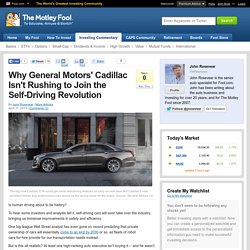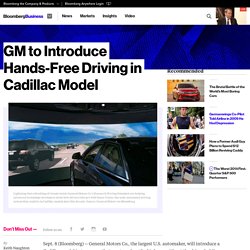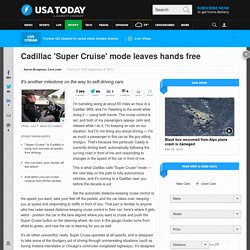

Why General Motors' Cadillac Isn't Rushing to Join the Self-Driving Revolution (GM) The big new Cadillac CT6 could get some self-driving features as early as next year.

But Cadillac's new president thinks fully autonomous cars would be the wrong move for the brand. Source: General Motors Co. Is human driving about to be history? To hear some investors and analysts tell it, self-driving cars will soon take over the industry, bringing us immense improvements in safety and efficiency. One big-league Wall Street analyst has even gone on record predicting that private ownership of cars will essentially come to an end by 2030 or so, as fleets of robot cars-for-hire provide for our transportation needs instead.
But is this all realistic? General Motors previews its new system for hands-free driving. General Motors is putting the final touches on a technology that allows the next generation of cars to practically drive themselves.

Current car models include technology that can alert a driver when he or she is drifting into another lane and allows cars to parallel park themselves. GM's new innovation, called Super Cruise, goes a step further: It keeps you in the lane by driving for you. It is one of a flurry of self-driving packages either already on the market or being readied by car makers from Detroit to Germany. Combining cruise control with steering, the Super Cruise system uses a network of cameras to steer the car between the lines at highway speeds and slow the car down if it comes too close to the vehicle in front. As CBS News correspondent Omar Villafranca learned, the driver's seat vibrates when it is time for a human to take back control. GM to Introduce Hands-Free Driving in Cadillac Model.
Sept. 8 (Bloomberg) -- General Motors Co., the largest U.S. automaker, will introduce a Cadillac model in two years that can travel on the highway without the driver holding the steering wheel or putting a foot on a pedal.

The 2017 Cadillac model will feature “Super Cruise” technology that takes control of steering, acceleration and braking at highway speeds of 70 miles per hour or in stop-and-go congested traffic, Chief Executive Officer Mary Barra said yesterday in a speech at the Intelligent Transport System World Congress in Detroit. GM declined to release the name of the model that will carry the feature. Barra also said GM in two years will become the first automaker to equip a model with so-called vehicle-to-vehicle technology that enables the car to communicate with other autos with similar abilities to warn of traffic hazards and improve road safety.
GM will make the V2V feature standard on its 2017 Cadillac CTS sedan, debuting in the second half of 2016, she said. Global Race. The 12 Most Important Questions About Self-Driving Cars. 7.

How safe is all this? Considering that semiautonomous cars rely on a network of active safety systems to work, they're pretty safe. The Insurance Institute for Highway Safety has found that we are already seeing the benefits of systems such as forward-collision warning in the reduction of accidents. That said, they're not 100 percent fail-proof. Chris Urmson leads Google's self-driving car program and is an adjunct professor at Carnegie Mellon University, where he also worked on DARPA's autonomous car challenges. Aside from the possibility of a system failure, semiautonomous technologies also have general limitations. 8. Nope. Of course, at 60 mph and in the middle of heavy traffic, the system can't physically force the driver to reengageand that's more than a little worrisome. 9.
Semiautonomous cars and vehicle-to-vehicle communication could profoundly change how traffic flows and even highway design. Near-Term Midterm Long-Term 10. 11. 12. Cadillac 'Super Cruise' mode leaves hands free. I'm barreling along at about 60 miles an hour in a Cadillac SRX, and I'm Tweeting to the world while doing it — using both hands.

The cruise control is set, and both of my passengers appear calm and relaxed while I do it. I'm keeping an eye on our situation, but I'm not doing any actual driving — I'm as much a passenger in this car as the guy sitting shotgun. GM Expects to Offer Hands-Free Driving by 2016. ‘Super Cruise’ Takes on Real-World Traffic Scenarios. Cadillac’s semi-automated vehicle technology undergoes further testing DETROIT – Development of “Super Cruise,” Cadillac’s semi-automated driving system, is advancing to the next stage of development, including real-world driving assessment and trials.

Cadillac projects this technology could make its way into production models later this decade. Research and development in active safety has already resulted in advancements on the road today in Cadillac’s new 2013 models, including the innovative Safety Alert Seat and Driver Awareness and Driver Assist features. In this next phase of development, engineers will drive Super Cruise vehicles in more and more challenging driving situations to test the system in a wide variety of environments to help refine it. “As we continually upgrade Super Cruise’s enabling technologies, it is important to expose the updated system to different environments,” said Jeremy Salinger, R&D manager for Super Cruise.
GM Expects to Offer Hands-Free Driving by 2016.